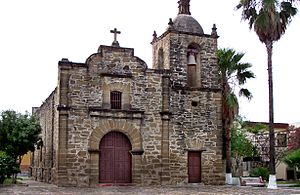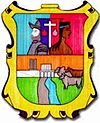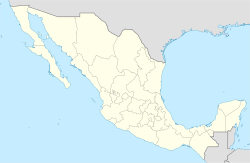Ciudad Mier facts for kids
Quick facts for kids
Ciudad Mier
|
||
|---|---|---|
 |
||
|
||
| Nickname(s):
Paso del Cántaro
|
||
| Founded | March 6, 1753 | |
| Founded as | Villa del Paso del Cántaro | |
| Founded by | José de Escandón | |
| Named for | Servando Teresa de Mier | |
| Population | ||
| • Total | 4,762 (city proper) | |
| Time zone | UTC-6 (CST) | |
| • Summer (DST) | UTC-5 (CDT) | |
Mier (pronounced "mee-air"), also known as El Paso del Cántaro (which means "The Jug Pass"), is a city in northern Mexico. It's located in the state of Tamaulipas, very close to the Rio Grande river. This river forms part of the border with the United States. Mier is about 90 miles northeast of Monterrey.
In 1990, about 6,190 people lived in Mier. By 2010, the population had become 4,762. The city's economy is mostly based on farming. They grow crops like cotton, sugar cane, and corn. They also raise livestock.
Contents
History of Mier
Mier was officially started on March 6, 1753. The land where the town was built first belonged to a person named Felix de Almandoz. Later, it was owned by General Prudencio Basterra.
The town got its name because a governor named Francisco Mier y Torre used to stay there. He was the governor of Nuevo León from 1710 to 1714. He would stop in Mier on his way to Texas. People started calling it "Estancia de Mier," meaning "Mier's Stopping Place." Eventually, it was just called Mier. This place was also a popular stop for steamboats traveling up the Río Bravo (Rio Grande).
Early Conflicts with Texas
Mier has a history of conflicts, especially with the Republic of Texas. In March 1842, General Ráfael Vásquez of Mexico led about 700 soldiers to take over San Antonio, Texas.
Texas President Sam Houston asked General Alexander Somervell to gather volunteers. Many people joined, some looking for adventure. However, these volunteers were not very organized. They started looting stores in San Antonio. This caused the group to break up before they could march into Mexico.
Things got worse between Texas and Mexico. In September, Mexican General Adrián Woll and 1,400 troops captured San Antonio again. President Houston once more asked General Somervell to lead volunteers. This time, the army grew to 750 men. They wanted to march into Mexico.
The Texas army slowly became disorganized. After capturing Laredo, about 500 men continued south with Somervell to Guerrero. More looting happened there. Then, a group of 189 men decided to leave Somervell's command. They followed leaders like William S. Fisher and Ewen Cameron into the Mexican town of Mier.
The Battle of Mier
On December 23, 1842, Fisher and his men crossed the Rio Grande. They entered Ciudad Mier without any fighting at first. They asked the town for supplies, and the town's mayor agreed to provide them. The Texans then waited outside the town. But while they waited, a large group of Mexican soldiers arrived in Mier.
On December 25, the Texans and Mexican forces began a fierce battle. It lasted for almost 24 hours. The Texans ran out of food, water, and ammunition. They also had about 30 soldiers injured or killed. More than 200 Texans surrendered to the Mexican army. They didn't know that they had caused huge losses to the Mexican troops, with about 800 Mexican soldiers injured or killed.
The Mexican government saw these Texans as raiders, not official soldiers. So, they were not treated as regular prisoners of war. They were sentenced to death and forced to march towards Mexico City. One of their leaders, Fisher, was separated from the group. The remaining men chose Ewen Cameron as their new leader.
The Black Bean Episode
Along the way, Cameron led most of the prisoners in an escape attempt. The Texans tried to run back to the border. But they faced very harsh and dry conditions in the mountains. All but three of them were caught again. They were taken back to a town called Salado.
When Mexican President Antonio López de Santa Anna heard about the escape, he ordered that all 176 recaptured prisoners be put to death. However, the Governor of Coahuila, Francisco Mexía, refused. He asked foreign ministers in Mexico City to convince the president to change his mind.
What happened next is known as the "Black Bean Episode." Santa Anna agreed to show some mercy. He changed his order to execute every tenth man. This meant that 17 men would be chosen to die. On March 25, 1843, at a place called El Rancho Salado, the prisoners were forced to draw a bean from a jar. They were blindfolded. The jar had 159 white beans and 17 black beans. Those who drew a black bean were executed that evening.
Ewen Cameron had drawn a white bean, which should have saved him. But a Mexican Colonel named Antonio Canales Rosillo disliked Cameron. Cameron had defeated Canales in a battle earlier. So, Canales asked Santa Anna to execute Cameron anyway. Santa Anna agreed. Cameron was executed by a firing squad on April 26, 1843.
The remaining prisoners were made to work on a road crew. Later, most of them were held at Perote Prison in Veracruz. Some died from injuries, sickness, or hunger. Diplomats from the United States and Great Britain worked to get the prisoners released. The last prisoner went home in September 1844.
In 1847, during the Mexican–American War, the remains of the men executed in the Black Bean Episode were brought back from Mexico. They were buried near La Grange, Texas, where a monument now stands.
Fidel Castro's Visit
Another interesting event in Mier's history happened in 1956. It involved Fidel Castro, who later became a leader in Cuba. At that time, Ciudad Mier had about 4,000 people. It was somewhat isolated and close to the U.S. border. This made it a place where people often smuggled goods.
Fidel Castro learned that many things could be brought illegally across the Rio Grande into Mier. Castro was planning a revolution in Cuba and needed weapons. He traveled to Mier to get them. A local historian, Antonio Guerra, said that only the best smugglers were chosen for this important job.
The task was given to Juan 'El Chapiado' González from Mier and Santiago 'El Chago' Guerra. These men got the weapons in the United States. Then, they brought them across the Rio Grande in boats. The weapons were unloaded at a ranch called Los Guajes.
After hiding the weapons, the group went to a bar called Cantina de la Loma del Peligro. There, they met the person buying the weapons. It was decided that the weapons would travel south from Mier to Aldamas. From there, they would go to Veracruz. Finally, they would be loaded onto a yacht named Granma.
Fidel Castro later confirmed that the weapons for the Cuban revolution indeed passed through Mier. Mexican smugglers helped him get them.
Abandonment of the City
In 2010, Ciudad Mier was largely abandoned. This happened because of a violent conflict between two criminal groups, the Gulf Cartel and Los Zetas.
About 95% of the people living in Ciudad Mier left their homes. They went to a nearby city called Miguel Alemán, Tamaulipas. Because of this, the president of Mexico at the time, Felipe Calderón, ordered a military base to be set up in the area. Now, more than 600 soldiers patrol the streets of Mier to help keep it safe.
Municipal Presidents
A municipal president is like a mayor who leads the city government. Here are some of the people who have served as municipal presidents of Mier:
- Nicolás Farías (1930–1933)
- Severo Barrera (1934–1936)
- Jesús García Gutiérrez (1937–1940)
- Florentino Ramírez Canales (1941–1942)
- Agustín Hinojosa Hinojosa (1943–1945)
- Valentín Barrera (1946–1948)
- Marcial Garza Sarabia (1949–1951)
- Julio Ramírez-Mateo García (1952–1954)
- Gerónimo Ramírez (1955–1957)
- Marco Hinojosa Villela (1958–1960)
- Álvaro Barrera Garza (1961–1962)
- Leonte Garza y Garza (1963–1965)
- Mauro Smith Bazán (1966–1968)
- Álvaro Barrera Garza (1969–1971)
- Roel Ramírez Ayala (1972–1974)
- Francisco Rodríguez Cavázos (1975–1977)
- Vladimir Treviño Rodríguez (1978–1980)
- Roberto González Guajardo (1981–1983)
- Ignacio Peña Alemán (1984–1986)
- Álvaro Barrera Ramírez (1987–1989)
- Jesús Humberto Hinojosa Vivanco (1990–1992)
- Enrique Maldonado Quintanilla (1993–1995)
- Jesús Ángel Guerra Mancías (1996–1998)
- Jesús Humberto Hinojosa Vivanco. (1999–2001)
- Abdón Canales Díaz (2002–2004)
- José Herbey Ramos Ramos (2005–2007)
- Roberto Gonzales Gonzales (2013-2016)
- Roberto González Hinojosa (2016-2018)
See also
 In Spanish: Mier para niños
In Spanish: Mier para niños



